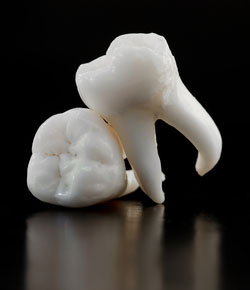
We know many out there indulge in watching video of dental patients coming off anesthesia after a major treatment or wisdom teeth removal. Having wisdom teeth taken out is really not a laughing matter, but it is a rite of passage in some, a stepping stone from childhood to young adulthood. While it is all well and good, it still begs the question – why is it necessary to have them removed?
As you mature, the third molars (wisdom teeth – the ones farthest back) are the last to develop, leaving little to no space for them to grow in the correct position. It’s easier to remove them before they have fully formed, at around the age of 25. Wisdom teeth received their name from usually arriving in the late teen years, signifying the passage into adulthood, hence the term “wisdom.”
If they are left to grow in, there is a good chance of infection or damaging other teeth through crowding. This can occur when the jaw is too small to fit the teeth. If they are not removed before they develop, they can damage nerves, which in turn causes constant pain.
Due to the location of wisdom teeth, it’s very difficult to efficiently brush and floss the area. This can cause painful tooth decay and cysts, as well as infecting nearby teeth. Being that they come in last, they often don’t have other teeth to guide the direction of their growth, leading to further discomfort. Their removal is beneficial to the health of the second molars, allowing easier reach for brushing and flossing, and eliminating a contact space for bacteria to grow.
Pericoronitis is an inflammation that leads to an infection in the tissue surrounding wisdom teeth. This infection is very painful, and has been known to send people to the ER. Swelling of the tongue can also occur, which closes the airway and can complicate respiration. Older patients are more susceptible to complications due to their bones becoming more brittle.
- Pain, swelling or jaw stiffness near an area impacted by the third molars.
- Crowding of other teeth is an issue from unsupervised wisdom teeth, because they can push other teeth and force them to crowd.
- An infected swelling in a flap of gum tissue formed on an impacted area.
- Even if you don’t have any symptoms there is still a possibility of needing to have them removed before they cause nerve damage.
How are these problems diagnosed?
The ideal age to start monitoring wisdom teeth growth is around 14, but development is different from patient to patient, which is why it’s important to monitor. The dentist will check signs of a wisdom tooth’s growth through the gum or crowding of nearby teeth and use a dental probe to feel the tooth. X-rays are used to see if problems may occur in the future by looking at the placement of the wisdom teeth. It may seem like a daunting task to have your wisdom teeth removed, but doing so can help prevent numerous complications to the teeth, gums and to oral health.
